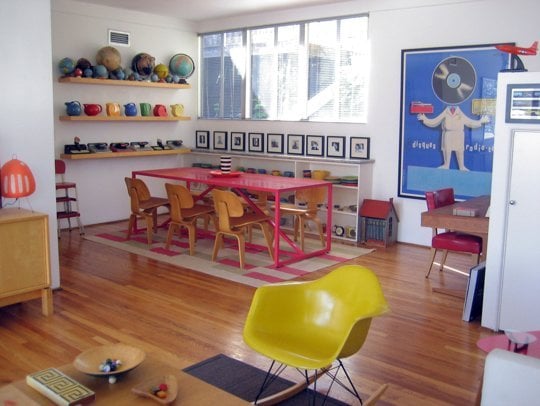Color is a universal language that, like any language, takes practice to become fluent in. And it’s this language that helps us decide how to choose paint colors or decor accents in our interior designs. Luckily, there are principals in color theory that teach us the typical human response to certain colors, but even those principals leave us with many questions.
For example: Red is scientifically proven to raise your heartbeat. It’s said to evoke passion, energy and hunger, while yellow is said to improve focus and productivity. But which hue or shade of these colors really works best and what if we simply don’t like those colors? Does this mean we should paint our walls these colors, or should we select furniture or artwork with these colors?
When it comes time to select paint colors and accents for our home interiors, these mental aerobics can leave us overwhelmed by the design process before it even starts. But the design must go on!
To help you improve your color fluency, we’ve put together some color-savvy guidelines that will have you thinking like a designer in no time.
Designing For Satisfaction
A room isn’t complete until it emotionally satisfies us. It has to move us. Unfortunately, there isn’t a one size-fits-all formula, but there are certain things we can learn in order to become more confident with our color decisions. As we begin to exercise our color fluency, there are a few basics to keep in mind:
Consider How It Makes You Feel

For professional designers, the process begins by establishing how a client wants to feel. It’s also vital to understand how they use a particular space and how those activities currently affect them throughout their daily routines.
Are they a morning person who wakes up early to cook a huge bacon and eggs breakfast for their family of five every Saturday? Or are they someone who hates to spend hours in the kitchen? Are they required to be productive in their space or relaxed, or maybe both?
From this perspective, we can see that color choices often originate from a desired feeling rather than an arbitrary color preference.
Make Purposeful Choices

There’s a common desire to pick colors that we “like” or that we’ve already incorporated into our wardrobes. And although it’s human nature to gravitate toward colors we’re familiar with, we must understand that the colors we choose within an interior space are applied differently and that other elements such as color relativity, lighting, texture, and room dimensions have a big impact.
It’s important to make intentional choices throughout the design process because every decision builds up to the next stage in the design. Therefore, a strong starting point for our color considerations can be found in understanding what emotional satisfaction we’re seeking. From there, we can begin to narrow down the selection process.
The Psychological Effects Of Color
Our perception of color is a personal one, and our emotional responses to it can vary depending on our personalities. Despite these complexities in how we experience color, there are still some predictions we can make about our color environments. The bottom line is that color is a human experience. When we think about color from this perspective, weighing our personalities and the expectations we have for our spaces, we can confidently develop color schemes!
Based on the research of our “color-expert forefathers” Faber Birren and Josef Albers, we can make some basic connections between colors and emotions.

Red
The most physical color in the spectrum, red is associated with the heart and blood, and has been proven to raise the heart rate and energy level. Used in interiors, the color makes a bold statement and is sometimes used in restaurants to increase appetite.
Orange
The color orange can encourage activity and stimulate conversations. In design, this vibrant and energetic color often has love-it or hate-it associations.
Yellow
The easiest color for the human eye to see, yellow speaks volumes based on its shade. Light yellow can bring warmth and softness to a space, while bright yellow can raise an emotional response and increase liveliness.
Green
Ever-present in nature, the color green can evoke a variety of moods. Used in the home, green is well suited in places meant for soothing and relaxing.
Blue
Blue is the color of a peaceful sky and the color of a calm sea. It’s a beacon of serenity and calmness – a perfect choice in design for bedrooms and other restful areas.
Violet
A combination of blue in red, blue draws an emotional impact that’s a balance of the two colors. Certain shades can uplift us, while others calm us. A wise color choice for creative spaces.
Neutrals
White, black, and grey, despite their simplicity, are big players in the color game. White, with all of its light reflecting qualities, is peaceful and clean, while black and grey can create significant depth within spaces.
Your Personal Tones And Shades

{Apartmenttherapy.com}
Now that we understand a little bit about color psychology, we can predict that if we want our room to feel cheerful, fresh, and spacious we might begin working off of a color palette of yellows, greens and blues. It’s at this point where we need to consider what styles we gravitate toward personally.
With tools like the Havenly style survey, we have the advantage of measuring our style preferences. For example, understanding that we have a “traditional” style might lead us toward the following palette:
- Buttercream yellow to warm the space
- Deeper blue to add a feeling of calm
- Olive toned green and sage to bring richness to the space
- White for balance and purity
Starting Points
With these guidelines in mind, it’s easy to see that the color vocabulary is a rich one. It’s clear that we need to choose our colors wisely, but that doesn’t mean it has to be a difficult decision. By understanding the way we emotionally relate to colors, and the way our personal style tastes relate to color schemes, we can find strong starting points toward design-savvy choices about paint colors and more.
At Havenly, our designers speak the language of color every day, all day. If you’re struggling to identify the right color for your space or you’re simply seeking a designer’s eye, why not try Havenly Mini – a room refresh with fresh accent & accessory suggestions, for only $79.
[df_divider el_width=”100″ style=”solid” accent_color=”#EEEEEE” border_t_width=”2px” padding=”20px 0″ position=”align_center” el_class=””]
 Melissa K.
Melissa K.
These color vocabulary tips are brought to you by Havenly designer Melissa K., who is a professional interior designer by trade. Melissa enjoys the process of working with clients to develop blissful lifestyles – one room at a time. She is keen on function and effortlessly understands your style, even when you don’t. She’ll help you create a space that you’ll love to call home! Book Melissa today and get decorated!
[df_divider el_width=”100″ style=”solid” accent_color=”#EEEEEE” border_t_width=”2px” padding=”20px 0″ position=”align_center” el_class=””]

